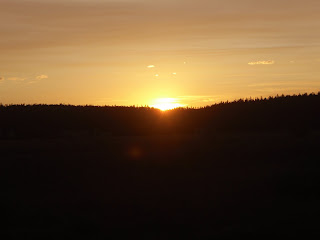 Watching Over You
Watching Over YouGet Dangerous and his buddies started talking, and you can rest assured the conversation will turn to how short life is. Right after our last adventure to southeastern Utah, Utah Jack read an article in the paper about a 60 year old man killed in a hiking accident. Maybe the man's age or the fact that he died in one of the canyons we visited a few weeks before got Dangerous telling anyone who would listen the old North West Indian legend about imminent death. According to the legend, sometimes a person receives a premonition about their impending death. You might hear them say, "I thought I heard the owl call my name."
I really think the legend is a bit too romantic for the High Plateau bunch. Those aren't owls circling over our heads as we ride and hike the canyon country. Even from my angle, I make out turkey vultures just waiting for an opportunity to swoop in. Take a look at these guys and you can tell there isn't anything mythical about their impending deaths. At their age, physical condition, and diet, you can rest assured that those circling buzzards don't have to whisper quietly in their ears because they already know they are one step or should I say horse ride away from their eternal rest.
I really think the legend is a bit too romantic for the High Plateau bunch. Those aren't owls circling over our heads as we ride and hike the canyon country. Even from my angle, I make out turkey vultures just waiting for an opportunity to swoop in. Take a look at these guys and you can tell there isn't anything mythical about their impending deaths. At their age, physical condition, and diet, you can rest assured that those circling buzzards don't have to whisper quietly in their ears because they already know they are one step or should I say horse ride away from their eternal rest.
You don't have to be a mind reader to figure out why those buzzards are up there waiting for the right opportunity. Circling overhead at 1500 feet they can pick out who eats right and takes care of themselves. I might be a sheep dog, but even I know diet pop won't ward of a premature buzzard visit when you consume 4,000 calories a day and clean up all the fat on your rib steak. Following the High Plateau diet plan may result in you hearing a buzzard call your name before your allotted time. Actually, turkey vultures don't call because they are mute. However, they do produce a loud hissing noise when agitated or excited. Can you imagine the hissing going on as they ponder the huge meal sitting in the chair next to the fire? "I thought I heard a buzzard hiss my name!"
 The More You Eat the Wider You Get
The More You Eat the Wider You GetSitting around the old campfire stuffing your face can negatively affect your physical conditioning. The lack of muscle tone usually shows up in a certain part of your anatomy. Infrequent exercise and over eating doesn't prepare you for the rigors of climbing slick rock ledges and cliffs trying to see an Anasazi ruin perched high above your head. You can't see them, but those buzzards are patiently circling above waiting for one of these overweight, out of shape hikers to fall out of the tree. At their age and physical condition, these guys don't have any business climbing up and down trees to access Indian ruins. "I thought I heard a buzzard hiss my name!"
 Who Says I'm Getting Old?
Who Says I'm Getting Old?No matter your diet and physical conditioning, time alone takes its toll. Fremont Bob is convinced that time isn't affecting him; because he tells us all the time he will live to be 115. He is so confident about his longevity that he continues to buy young mules. For equines, mules are extremely long lived with life spans extending 40 years or more. I am no expert on the human condition, but a close look at the picture convinces me that Fremont ought to stick with old horses. A man's age isn't just reflected in those "laugh lines" around his eyes, but in changing behavior. Fremont has acquired a lap dog; now all he needs is a retirement condominium in St. George. "I thought I heard a buzzard hiss my name!"
 Checking Out Final Resting Spots
Checking Out Final Resting SpotsAs you probably know by now, Ol' Dangerous isn't the most optimistic human. He will tell you that a pessimist is really an optimist with all the facts. Well, there are times when I believe he takes his fact gathering and planning too far. Wherever we hike or ride, he is on the lookout for a nice burial spot. What's really embarrassing is he actually tries them out. Sometimes he will lie down on the ground to admire the view from different angles. I really get upset when he asks me to lie down next to him to see if there is room for both of us. "I thought I heard a buzzard hiss my name!"
 Setting Sun
Setting SunThe sun might be setting on this bunch of aging outdoors-men, but I think they will continue in their old habits as long as they can. Red meat will be an ongoing part of their diets, and Utah Jack will avoid regular aerobic exercise at all costs. I am sure they will wear out more hiking boots and saddle leather before one of them admits to hearing "a buzzard calling his name!" Love to hear from you!















